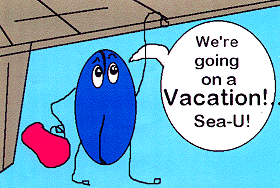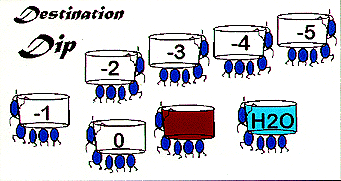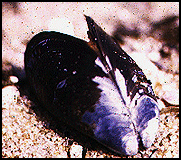 |
||||||
| Articles | Projects | Resume | Cartoons | Windsurfing | Paintings | Album |
The Effects of Pulp Mill Effluent on
Byssal Thread Production by the
Marine Blue Mussel Mytilus edulis
by Waterose


Section 2. Procedures:
The experiment was completed only once due to the revisions to the experimental design that were required after the completion of the first trial. There were five individual organisms used per solution to provide replicates. The pulp mill effluents were obtained from Fletcher Challenge Pulp and Paper mill, located in Crofton, BC. on May 5, 1998. The effluents were stored in cold storage between trial experiments.
2.1 Procedures for Collection of Mussels:

2.2 Procedures for Preparation of Solutions:

2.3 Procedures for Measurement of Abiotic Water Chemistry Parameters:

2.4 Procedures for Incubation of Organisms:

2.1 Procedures for Collection of Mussels:
A sample of Blue Mussels was collected from the marine dock at Royal Roads University Tuesday May 5, 1998 at 2:30 pm. The tide was high and the temperature of the water was 20 dC. The gradient of the slope from the shore to the dock was gentle and the water was shallow which could possibly account for the warm water temperature. Water samples were obtained from a surface area adjacent to the mussel population of study organisms. The pH was 7.84 and the ion concentration was beyond detection limits of the meter.
The community of mussels was attached to a piece of dock bumper consisting of an old fire hose which was approximately one meter long and dangling from the dock down into the water. The hose was removed from the dock and transported to the laboratory aquarium.
A preliminary trial was run to observe byssal thread regeneration of five organisms of different sizes. The five organisms were dissected from the original substrate and placed into a glass container in the aquarium with an assortment of different substrate options including the glass dish, an oyster shell, and a rock. The trial test was examined for regeneration over the next seven days to determine a reasonable end point. There was visible regeneration after one day with adequate regeneration after two days. This was used to determine the experimental end-point of forty-eight hours.
The experimental results for trial 1 were not successful because the entire sample set expired, including the samples in the control. The experimental procedure was modified to include aeration of the solutions during the test period, and replacement of the solutions with fresh solutions at mid-point during the test period. The collection procedure was repeated on May 12, 1998 at 12:30 pm to obtain fresh test organisms from the original home site and the modified experimental procedure was completed.
The experiment assessed the effects of six different concentrations of untreated pulp mill effluent diluted in sea water, one pure concentration of treated effluent and one sea water control. Forty individual organisms of similar size were removed from their original substrate, a piece of wide nylon webbing, which was hanging from the dock. The organisms were detached from the substrate by severing the byssal threads with a scalpel and a razor blade. Barnacles and algae growth were removed from each mussel. The length of each mussel was measured on the longest axis with metric callipers and recorded.
2.2 Procedures for Preparation of Solutions:
Five organisms were placed into eight similar 1000 mL glass beakers which contained solutions as follows: one control of undiluted sea water solution, one undiluted treated effluent solution, and six logarithmic dilutions of untreated pulp mill effluent and sea water solutions. The dilutions were obtained in the following manner.
- 800 mL of sea water was placed in beaker number 1 and five mussels are inserted;
- 800 mL of treated effluent was placed in beaker number 2 and five mussels were inserted;
- 800 mL of untreated effluent was placed in beaker number three and five mussels were inserted;
- 80 mL of untreated effluent was placed in beaker number 4. The beaker was topped up to 800 mL through the addition of sea water. The liquid was mixed thoroughly and 80 mL was drawn off and placed in beaker number 5. The five mussels were then added to beaker number 4;
- 720 mL of sea water was added to beaker 5 to top it off to 800 mL. The mixture was thoroughly mixed and 80 mL was drawn off and added to beaker 6. The mussels were then added;
- repeat step 5 three more times.
This procedure results in logarithmically decreasing dilutions of : 100, 10-1, 10-2, 10-3, 10-4, and 10-5 of untreated effluent:sea water. A duplicate set of solutions was prepared and stored in the cold room to replace the first set of solutions at the mid-point of twenty-four hours.
2.3 Procedures for Measurement of Abiotic Water Chemistry Parameters:
The physical parameters of the solutions were tested for pH, temperature, salinity, and conductivity. Biological oxygen demand (BOD) was not tested due to the lack of BOD testing apparatus.
The pH/Temperature meter was a model BARNANT30 digital pH (ATC) electro-chemical meter. The pH range is pH 0.00 to 14.00. The precision is plus/minus pH 0.01 and plus/minus 0.5 degrees Celsius for Temperature. The pH is calibrated in pH 4.00 and pH 7.00 solutions at room temperature. In addition to the electronic digital temperature obtained, a second temperature measurement was obtained with a standard glass vacuum thermometer.
The Salinity Refractometer was a S/Mill Model 2441-W05 mechanical model. The scale measure parts per thousand to one decimal place. The salinity refractometer was standardised with de-ionised water to zero.
The conductivity meter was a model 1481-60 digital unit which measures ions in solution. It functions with an automatic temperature compensator. It was calibrated to 0.127, (at 20,000) at 20.0 degrees Celsius with a brine solution.
2.4 Procedures for Incubation of Organisms:
The test containers were incubated in a cold storage room maintained at 8-12 degrees Celsius, with constant aeration and no feeding for forty-eight hours. The solutions were replaced for each container after twenty-four hours with the second set of prepared solutions. The byssal thread growth/regeneration was monitored and observations/measurements recorded at the end point of forty-eight hours. The regenerated byssal threads were cut from the glass container with a scalpel, and dissected from the test organism and weighed for each group of individuals in the solution container.
To Section 3. Results:
Index:
- Introduction:
- Procedure:
- Results:
- Discussion:
- Future Study:
- References:
- Appendix I. Trial 1:
- Postscript:


 email Waterose
email Waterose
Please Sign My Guestbook
Please View My Guestbook

| Articles | Projects | Resume | Cartoons | Windsurfing | Paintings | Album |
 | ||||||
